>>>Natures Of Universe<<<
Home Page › Forums › API Clubhouse › Interesting Shows/Websites/Book Previews › >>>Natures Of Universe<<<
- This topic is empty.
-
AuthorPosts
-
October 25, 2005 at 5:05 am #5138
Anonymous
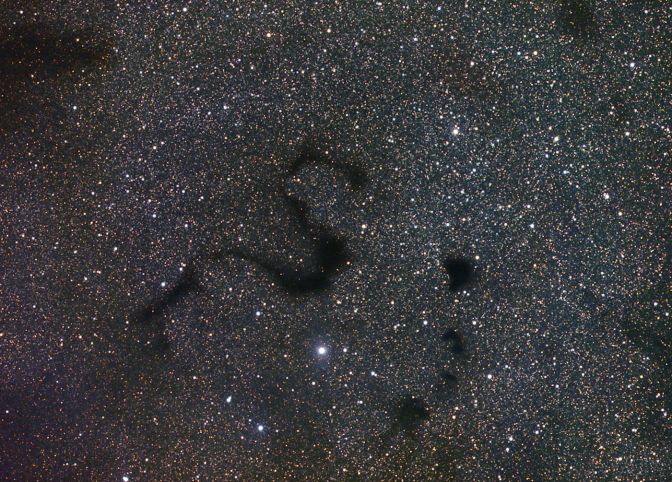
Snake in the Dark
Explanation: Dark nebulae snake across a gorgeous expanse of stars in this wide-field view toward the pronounceable constellation Ophiucus and the center of our Milky Way Galaxy. In fact, the central S-shape seen here is well known as the Snake Nebula. It is also listed as Barnard 72 (B72), one of 182 dark markings of the sky cataloged in the early 20th century by astronomer E. E. Barnard. Unlike bright emission nebulae and star clusters, Barnard’s nebulae are interstellar dark clouds of obscuring gas and dust. Their shapes are visible in cosmic silhouette only because they lie in the foreground along the line of sight to rich star fields and glowing stellar nurseries near the plane of our Galaxy. Many of Barnard’s dark nebulae are themselves likely sites of future star formation. Barnard 72 is a few light years across and about 650 light years away.
Credit & Copyright: Gary Stevens
October 25, 2005 at 5:06 am #5139Anonymous

The Dust and Ion Tails of Comet Hale-Bopp
Explanation: In 1997, Comet Hale-Bopp’s intrinsic brightness exceeded any comet since 1811. Since it peaked on the other side of the Earth’s orbit, however, the comet appeared only brighter than any comet in two decades. Visible above are the two tails shed by Comet Hale-Bopp. The blue ion tail is composed of ionized gas molecules, of which carbon monoxide particularly glows blue when reacquiring electrons. This tail is created by the particles from the fast solar wind interacting with gas from the comet’s head. The blue ion tail points directly away from the Sun. The light colored dust tail is created by bits of grit that have come off the comet’s nucleus and are being pushed away by the pressure of light from the Sun. This tail points nearly away from the Sun. The above photograph was taken in March 1997.
Credit & Copyright: John Gleason (Celestial Images)
October 25, 2005 at 5:07 am #5140Anonymous
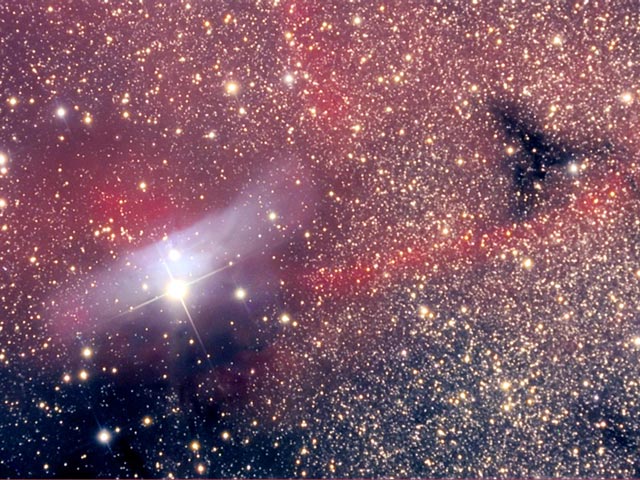
Swirls and Stars in IC 4678
Explanation: Swirls of gas and dust enrich this little observed starfield toward the constellation of Sagittarius. Just to the side of the more often photographed Lagoon Nebula (M8) and the Trifid Nebula (M20) lies this busy patch of sky dubbed IC 4678. Prominent in the above image are large emission nebulas of red glowing gas highlighted by unusually bright red filaments. On the left, a band of thin dust preferentially reflects the blue light of a bright star creating a small reflection nebula. On the right and across the bottom, swaths of thicker dust appear as dark absorption nebulas, blocking the light from stars farther in the distance. IC 4678 spans about 25 light years and lies about 5,000 light years distant.
Credit & Copyright: Ken Siarkiewicz & Adam Block, NOAO, AURA, NSF
October 25, 2005 at 5:10 am #5141Anonymous
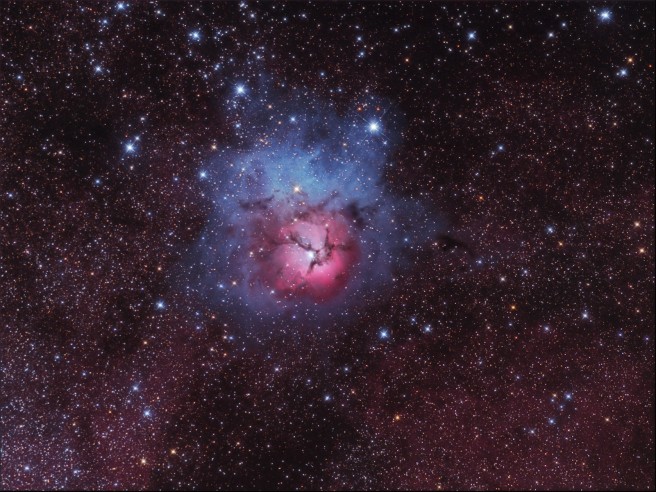
A Beautiful Trifid
Explanation: The beautiful Trifid Nebula (aka M20), a photogenic study in cosmic contrasts, lies about 5,000 light-years away toward the nebula rich constellation Sagittarius. A star forming region in the plane of our galaxy, the Trifid fittingly illustrates three basic types of astronomical nebulae; red emission nebulae dominated by light from hydrogen atoms, blue reflection nebulae produced by dust reflecting starlight, and dark absorption nebulae where dense dust clouds appear in silhouette. The bright red emission nebula, roughly separated into three parts by obscuring dust lanes, lends the Trifid its popular name. In this gorgeous wide view, the red emission region is also surrounded by the telltale blue haze of reflection nebulae. Light-year long pillars and jets sculpted by newborn stars – visible here below the center of the emission nebula – appear in Hubble Space Telescope close-up images of the region.
Credit & Copyright: Dean Jacobsen
October 25, 2005 at 5:10 am #5142Anonymous
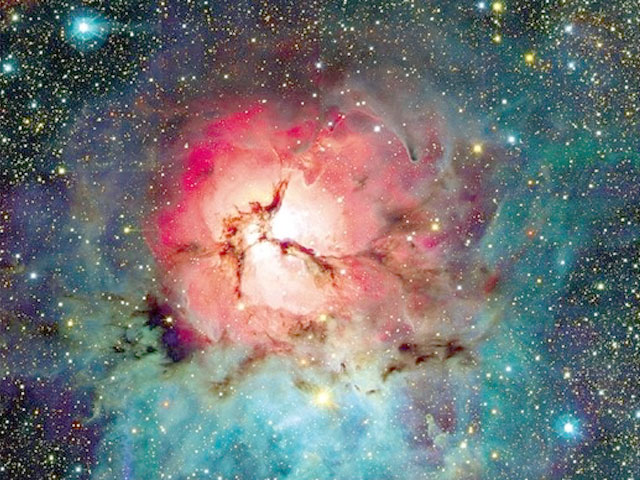
The Trifid Nebula from CFHT
Explanation: Unspeakable beauty and unimaginable bedlam can be found together in the Trifid Nebula. Also known as M20, this photogenic nebula is visible with good binoculars towards the constellation of Sagittarius. The energetic processes of star formation create not only the colors but the chaos. The red-glowing gas results from high-energy starlight striking interstellar hydrogen gas. The dark dust filaments that lace M20 were created in the atmospheres of cool giant stars and in the debris from supernovae explosions. Which bright young stars light up the blue reflection nebula is still being investigated. The light from M20 we see today left perhaps 3,000 years ago, although the exact distance remains unknown. Light takes about 50 years to cross M20.
Credit & Copyright: Jean-Charles Cuillandre (CFHT), Hawaiian Starlight, CFHT
October 25, 2005 at 5:12 am #5143Anonymous
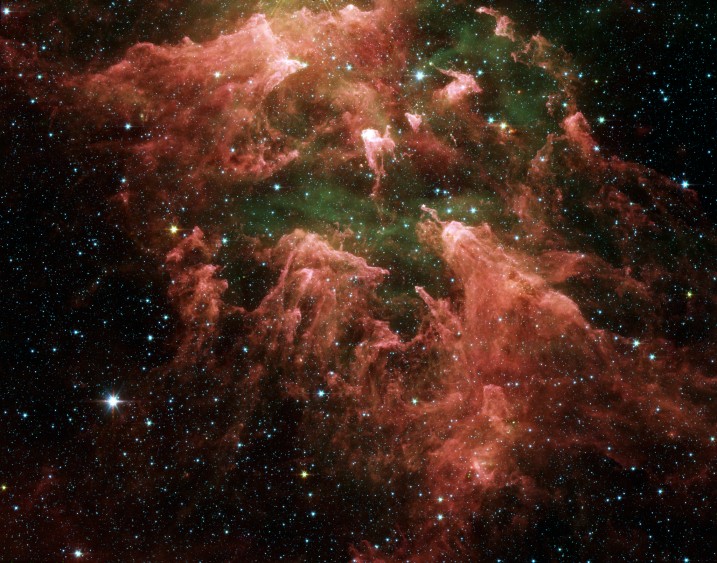
Sculpting the South Pillar
Explanation: Eta Carinae, one of the most massive and unstable stars in the Milky Way Galaxy, has a profound affect on its environment. Found in the the South Pillar region of the Carina Nebula, these fantastic pillars of glowing dust and gas with embedded newborn stars were sculpted by the intense wind and radiation from Eta Carinae and other massive stars. Glowing brightly in planet Earth’s southern sky, the expansive Eta Carinae Nebula is a mere 10,000 light-years distant. Still, this remarkable cosmic vista is largely obscured by nebular dust and only revealed here in penetrating infrared light by the Spitzer Space Telescope. Eta Carinae itself is off the top left of the false-color image, with the bright-tipped dust pillars pointing suggestively toward the massive star’s position. The Spitzer image spans almost 200 light-years at the distance of Eta Carinae.
Credit: Nathan Smith (Univ. of Colorado), et al., SSC, JPL, Caltech, NASA
October 25, 2005 at 5:13 am #5144Anonymous
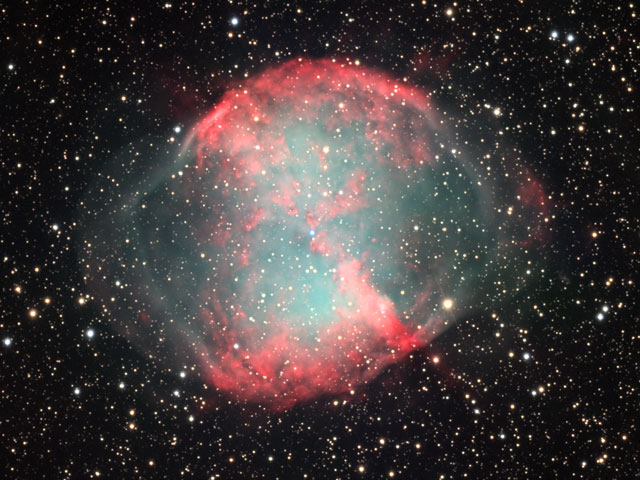
M27: The Dumbbell Nebula
Explanation: The first hint of what will become of our Sun was discovered inadvertently in 1764. At that time, Charles Messier was compiling a list of diffuse objects not to be confused with comets. The 27th object on Messier’s list, now known as M27 or the Dumbbell Nebula, is a planetary nebula, the type of nebula our Sun will produce when nuclear fusion stops in its core. M27 is one of the brightest planetary nebulae on the sky, and can be seen in the constellation Vulpecula with binoculars. It takes light about 1000 years to reach us from M27, shown above, digitally sharpened, in three standard colors. Understanding the physics and significance of M27 was well beyond 18th century science. Even today, many things remain mysterious about bipolar planetary nebula like M27, including the physical mechanism that expels a low-mass star’s gaseous outer-envelope, leaving an X-ray hot white dwarf.
Credit & Copyright: Joe & Gail Metcalf, Adam Block, NOAO, AURA, NSF
October 25, 2005 at 5:15 am #5145Anonymous
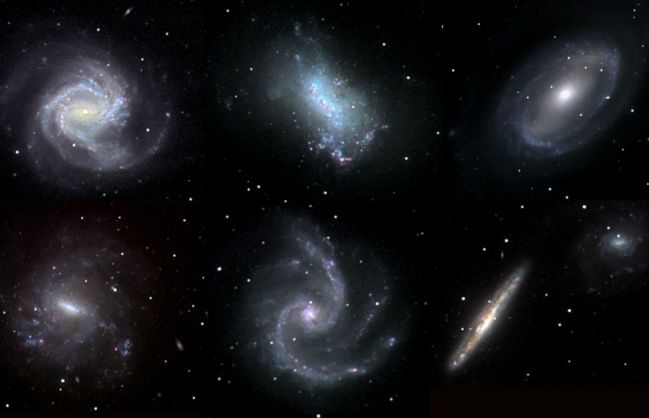
Visitors’ Galaxy Gallery
Explanation: A tantalizing assortment of island universes is assembled here. From top left to bottom right are the lovely but distant galaxies M61, NGC 4449, NGC 4725, NGC 5068, NGC 5247, and NGC 5775/5774. Most are spiral galaxies more or less like our own Milky Way. The color images reveal distinct pink patches marking the glowing hydrogen gas clouds in star forming regions along the graceful spiral arms. While Virgo cluster galaxy M61 is perhaps the most striking of these spirals, the interesting galaxy pair NGC 5775/5774 neatly contrasts the characteristic spiral edge-on and face-on appearance. The one exception to this parade of photogenic spiral galaxies is the small and relatively close irregular galaxy NGC 4449 (top middle). Similar to the Large Magellanic Cloud, companion galaxy to the Milky Way, NGC 4449 also sports young blue star clusters and pink star forming regions. All the galaxies in this gallery were imaged with a small (16 inch diameter) reflecting telescope and digital camera by public participants in the Kitt Peak National Observatory Visitor Center’s Advanced Observing Program.Credit: Courtesy Adam Block (KPNO Visitor Program), NOAO, NSF
October 25, 2005 at 5:17 am #5146Anonymous
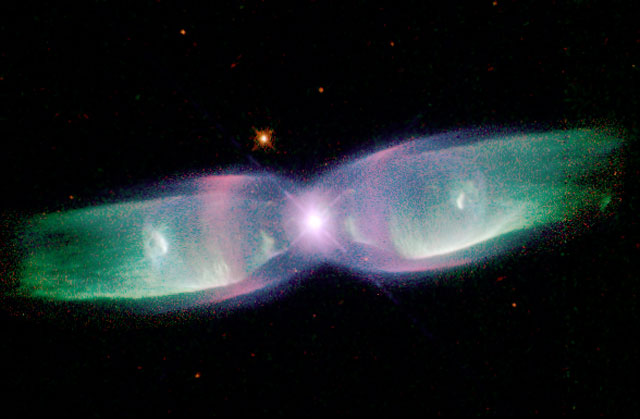
M2-9: Wings of a Butterfly Nebula
Explanation: Are stars better appreciated for their art after they die? Actually, stars usually create their most artistic displays as they die. In the case of low-mass stars like our Sun and M2-9 pictured above, the stars transform themselves from normal stars to white dwarfs by casting off their outer gaseous envelopes. The expended gas frequently forms an impressive display called a planetary nebula that fades gradually over thousand of years. M2-9, a butterfly planetary nebula 2,100 light-years away shown in representative colors, has wings that tell a strange but incomplete tale. In the center, two stars orbit inside a gaseous disk 10 times the orbit of Pluto. The expelled envelope of the dying star breaks out from the disk creating the bipolar appearance. Much remains unknown about the physical processes that cause planetary nebulae.
Credit: B. Balick (U. Washington) et al., WFPC2, HST, NASA
October 25, 2005 at 5:18 am #5147Anonymous

Spherical Planetary Nebula Abell 39
Explanation: Ghostly in appearance, Abell 39 is a remarkably simple, spherical nebula about five light-years across. Well within our own Milky Way galaxy, the cosmic sphere is roughly 7,000 light-years distant toward the constellation Hercules. Abell 39 is a planetary nebula, formed as a once sun-like star’s outer atmosphere was expelled over a period of thousands of years. Still visible, the nebula’s central star is evolving into a hot white dwarf. Although faint, the nebula’s simple geometry has proven to be a boon to astronomers exploring the chemical abundances and life cycles of stars. In this deep image recorded under dark night skies, very distant background galaxies can be found — some visible right through the nebula itself.
Credit & Copyright: Jim Misti (Misti Mountain Observatory)
October 25, 2005 at 5:19 am #5148Anonymous
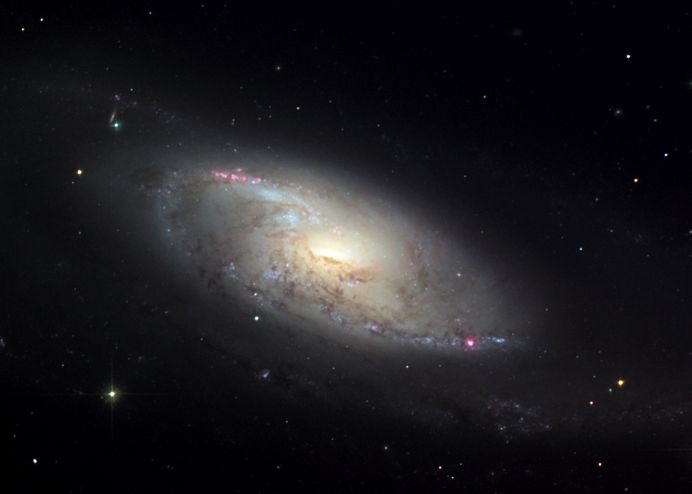
M106 in Canes Venatici
Explanation: Close to the Great Bear (Ursa Major) and surrounded by the stars of the Hunting Dogs (Canes Venatici), this celestial nebula was discovered in 1781 by the metric French astronomer Pierre Mechain. Later, it was added to the catalog of his friend and colleague Charles Messier as M106. Modern deep telescopic views reveal it to be an island universe — a spiral galaxy around 30 thousand light-years across located only about 21 million light-years beyond the stars of the Milky Way. Youthful blue star clusters and reddish stellar nurseries trace the striking spiral arms of M106. Seen so clearly in this beautiful image, the galaxy’s bright core is also visible across the spectrum from radio to x-rays, making M106 a nearby example of the Seyfert class of active galaxies. The bright core of a Seyfert galaxy is believed to be powered by matter falling into a massive central black hole.
Credit: Bernie and Jay Slotnick, Adam Block, AOP, NOAO, AURA, NSF
October 25, 2005 at 5:21 am #5149Anonymous

The Busy Center of the Lagoon Nebula
Explanation: Stars are battling gas and dust in the Lagoon Nebula but the photographers are winning. Also known as M8, this photogenic nebula is visible even without binoculars towards the constellation of Sagittarius. The energetic processes of star formation create not only the colors but the chaos. The red-glowing gas results from high-energy starlight striking interstellar hydrogen gas. The dark dust filaments that lace M8 were created in the atmospheres of cool giant stars and in the debris from supernovae explosions. This spectacular portion of the Lagoon Nebula was created in scientifically-assigned colors from light emitted in very specific colors by hydrogen, silicon, and oxygen. The light from M8 we see today left about 5,000 years ago. Light takes about 50 years to cross this section of M8.
Credit & Copyright: Michael Sherick
October 25, 2005 at 5:26 am #5150Anonymous

Supernova Remnant N132D in Optical and X Rays
Credit : NASA, ESA, and The Hubble Heritage Team (STScI/AURA)
Acknowledgment: J.C. Green (Univ. of Colorado) and the Cosmic Origins Spectrograph (COS) GTO team; NASA/CXO/SAOExplanation: Thousands of years after a star exploded, its expanding remnant still glows brightly across the spectrum. Such is the case with N132D, a supernova remnant located in the neighboring Large Magellanic Cloud (LMC) galaxy. The expanding shell from this explosion now spans 80 light-years and has swept up about 600 Suns worth of mass. N132D was imaged recently in optical light and in great detail with the Hubble Space Telescope. The Hubble image was then combined with a position coincident detailed image in X-ray light taken by the Chandra X-ray Observatory. The combination, shown above in representative colors, shows a nearly spherical expanding shockwave highlighted by pink emission from hydrogen gas and purple emission from oxygen gas. A dense field of unrelated stars also from the LMC populates the image. Studying the image gives an opportunity to study material once hidden deep inside a star. N132D spans about 150 light years and lies about 160,000 light years away toward the constellation of Dorado.
October 25, 2005 at 9:55 am #5151Anonymous
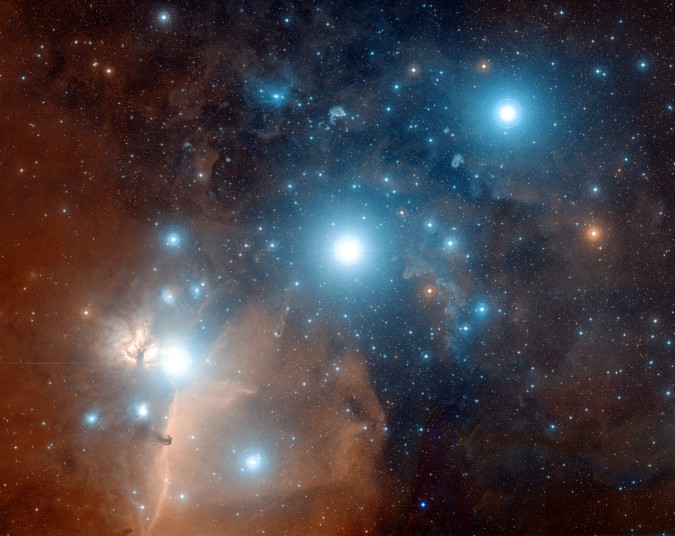
Alnitak, Alnilam, Mintaka
Explanation: Alnitak, Alnilam, and Mintaka, are the bright bluish stars from east to west (left to right) along the diagonal in this gorgeous cosmic vista. Otherwise known as the Belt of Orion, these three blue supergiant stars are hotter and much more massive than the Sun. They lie about 1,500 light-years away, born of Orion’s well-studied interstellar clouds. In fact, clouds of gas and dust adrift in this region have intriguing and some surprisingly familiar shapes, including the dark Horsehead Nebula and Flame Nebula near Alnitak at the lower left. The famous Orion Nebula itself lies off the bottom of this star field that covers an impressive 4.4×3.5 degrees on the sky. The color picture was composited from digitized black and white photographic plates recorded through red and blue astronomical filters, with a computer synthesized green channel. The plates were taken using the Samuel Oschin Telescope, a wide-field survey instrument at Palomar Observatory, between 1987 and 1991.
Credit: Digitized Sky Survey, ESA/ESO/NASA FITS Liberator
Color Composite: Davide De Martin (Skyfactory)October 25, 2005 at 9:57 am #5152Anonymous

Dusty Environs of Eta Carinae
Explanation: Eta Car is a massive star, but it’s not as bright as it used to be. Now only easily visible in binoculars or a small telescope, Eta Carinae has a history of spectacular flaring and fading behavior. In fact, in April of 1843 Eta Car briefly became second only to Sirius as the brightest star in planet Earth’s night sky, even though at a distance of about 7,500 light-years, it is about 800 times farther away. Surrounded by a complex and evolving nebula, Eta Carinae is seen near the center of this false-color infrared image, constructed using data from the Midcourse Space Experiment (MSX). The MSX satellite mapped the galactic plane in 1996. In the picture, wispy, convoluted filaments are clouds of dust glowing at infrared wavelengths. Astronomers hypothesize that Eta Car itself will explode as a supernova in the next million years or so. Massive Eta Car has even been considered a candidate for a hypernova explosion and the potential source of a future gamma-ray burst.
Credit: MSX, IPAC, NASA
-
AuthorPosts
-
AuthorPosts
-
Anonymous- Offline

Snake in the Dark
Explanation: Dark nebulae snake across a gorgeous expanse of stars in this wide-field view toward the pronounceable constellation Ophiucus and the center of our Milky Way Galaxy. In fact, the central S-shape seen here is well known as the Snake Nebula. It is also listed as Barnard 72 (B72), one of 182 dark markings of the sky cataloged in the early 20th century by astronomer E. E. Barnard. Unlike bright emission nebulae and star clusters, Barnard’s nebulae are interstellar dark clouds of obscuring gas and dust. Their shapes are visible in cosmic silhouette only because they lie in the foreground along the line of sight to rich star fields and glowing stellar nurseries near the plane of our Galaxy. Many of Barnard’s dark nebulae are themselves likely sites of future star formation. Barnard 72 is a few light years across and about 650 light years away.
Credit & Copyright: Gary Stevens
Anonymous- Offline

The Dust and Ion Tails of Comet Hale-Bopp
Explanation: In 1997, Comet Hale-Bopp’s intrinsic brightness exceeded any comet since 1811. Since it peaked on the other side of the Earth’s orbit, however, the comet appeared only brighter than any comet in two decades. Visible above are the two tails shed by Comet Hale-Bopp. The blue ion tail is composed of ionized gas molecules, of which carbon monoxide particularly glows blue when reacquiring electrons. This tail is created by the particles from the fast solar wind interacting with gas from the comet’s head. The blue ion tail points directly away from the Sun. The light colored dust tail is created by bits of grit that have come off the comet’s nucleus and are being pushed away by the pressure of light from the Sun. This tail points nearly away from the Sun. The above photograph was taken in March 1997.
Credit & Copyright: John Gleason (Celestial Images)
Anonymous- Offline

Swirls and Stars in IC 4678
Explanation: Swirls of gas and dust enrich this little observed starfield toward the constellation of Sagittarius. Just to the side of the more often photographed Lagoon Nebula (M8) and the Trifid Nebula (M20) lies this busy patch of sky dubbed IC 4678. Prominent in the above image are large emission nebulas of red glowing gas highlighted by unusually bright red filaments. On the left, a band of thin dust preferentially reflects the blue light of a bright star creating a small reflection nebula. On the right and across the bottom, swaths of thicker dust appear as dark absorption nebulas, blocking the light from stars farther in the distance. IC 4678 spans about 25 light years and lies about 5,000 light years distant.
Credit & Copyright: Ken Siarkiewicz & Adam Block, NOAO, AURA, NSF
Anonymous- Offline

A Beautiful Trifid
Explanation: The beautiful Trifid Nebula (aka M20), a photogenic study in cosmic contrasts, lies about 5,000 light-years away toward the nebula rich constellation Sagittarius. A star forming region in the plane of our galaxy, the Trifid fittingly illustrates three basic types of astronomical nebulae; red emission nebulae dominated by light from hydrogen atoms, blue reflection nebulae produced by dust reflecting starlight, and dark absorption nebulae where dense dust clouds appear in silhouette. The bright red emission nebula, roughly separated into three parts by obscuring dust lanes, lends the Trifid its popular name. In this gorgeous wide view, the red emission region is also surrounded by the telltale blue haze of reflection nebulae. Light-year long pillars and jets sculpted by newborn stars – visible here below the center of the emission nebula – appear in Hubble Space Telescope close-up images of the region.
Credit & Copyright: Dean Jacobsen
Anonymous- Offline

The Trifid Nebula from CFHT
Explanation: Unspeakable beauty and unimaginable bedlam can be found together in the Trifid Nebula. Also known as M20, this photogenic nebula is visible with good binoculars towards the constellation of Sagittarius. The energetic processes of star formation create not only the colors but the chaos. The red-glowing gas results from high-energy starlight striking interstellar hydrogen gas. The dark dust filaments that lace M20 were created in the atmospheres of cool giant stars and in the debris from supernovae explosions. Which bright young stars light up the blue reflection nebula is still being investigated. The light from M20 we see today left perhaps 3,000 years ago, although the exact distance remains unknown. Light takes about 50 years to cross M20.
Credit & Copyright: Jean-Charles Cuillandre (CFHT), Hawaiian Starlight, CFHT
Anonymous- Offline

Sculpting the South Pillar
Explanation: Eta Carinae, one of the most massive and unstable stars in the Milky Way Galaxy, has a profound affect on its environment. Found in the the South Pillar region of the Carina Nebula, these fantastic pillars of glowing dust and gas with embedded newborn stars were sculpted by the intense wind and radiation from Eta Carinae and other massive stars. Glowing brightly in planet Earth’s southern sky, the expansive Eta Carinae Nebula is a mere 10,000 light-years distant. Still, this remarkable cosmic vista is largely obscured by nebular dust and only revealed here in penetrating infrared light by the Spitzer Space Telescope. Eta Carinae itself is off the top left of the false-color image, with the bright-tipped dust pillars pointing suggestively toward the massive star’s position. The Spitzer image spans almost 200 light-years at the distance of Eta Carinae.
Credit: Nathan Smith (Univ. of Colorado), et al., SSC, JPL, Caltech, NASA
Anonymous- Offline

M27: The Dumbbell Nebula
Explanation: The first hint of what will become of our Sun was discovered inadvertently in 1764. At that time, Charles Messier was compiling a list of diffuse objects not to be confused with comets. The 27th object on Messier’s list, now known as M27 or the Dumbbell Nebula, is a planetary nebula, the type of nebula our Sun will produce when nuclear fusion stops in its core. M27 is one of the brightest planetary nebulae on the sky, and can be seen in the constellation Vulpecula with binoculars. It takes light about 1000 years to reach us from M27, shown above, digitally sharpened, in three standard colors. Understanding the physics and significance of M27 was well beyond 18th century science. Even today, many things remain mysterious about bipolar planetary nebula like M27, including the physical mechanism that expels a low-mass star’s gaseous outer-envelope, leaving an X-ray hot white dwarf.
Credit & Copyright: Joe & Gail Metcalf, Adam Block, NOAO, AURA, NSF
Anonymous- Offline

Visitors’ Galaxy Gallery
Explanation: A tantalizing assortment of island universes is assembled here. From top left to bottom right are the lovely but distant galaxies M61, NGC 4449, NGC 4725, NGC 5068, NGC 5247, and NGC 5775/5774. Most are spiral galaxies more or less like our own Milky Way. The color images reveal distinct pink patches marking the glowing hydrogen gas clouds in star forming regions along the graceful spiral arms. While Virgo cluster galaxy M61 is perhaps the most striking of these spirals, the interesting galaxy pair NGC 5775/5774 neatly contrasts the characteristic spiral edge-on and face-on appearance. The one exception to this parade of photogenic spiral galaxies is the small and relatively close irregular galaxy NGC 4449 (top middle). Similar to the Large Magellanic Cloud, companion galaxy to the Milky Way, NGC 4449 also sports young blue star clusters and pink star forming regions. All the galaxies in this gallery were imaged with a small (16 inch diameter) reflecting telescope and digital camera by public participants in the Kitt Peak National Observatory Visitor Center’s Advanced Observing Program.Credit: Courtesy Adam Block (KPNO Visitor Program), NOAO, NSF
Anonymous- Offline

M2-9: Wings of a Butterfly Nebula
Explanation: Are stars better appreciated for their art after they die? Actually, stars usually create their most artistic displays as they die. In the case of low-mass stars like our Sun and M2-9 pictured above, the stars transform themselves from normal stars to white dwarfs by casting off their outer gaseous envelopes. The expended gas frequently forms an impressive display called a planetary nebula that fades gradually over thousand of years. M2-9, a butterfly planetary nebula 2,100 light-years away shown in representative colors, has wings that tell a strange but incomplete tale. In the center, two stars orbit inside a gaseous disk 10 times the orbit of Pluto. The expelled envelope of the dying star breaks out from the disk creating the bipolar appearance. Much remains unknown about the physical processes that cause planetary nebulae.
Credit: B. Balick (U. Washington) et al., WFPC2, HST, NASA
Anonymous- Offline

Spherical Planetary Nebula Abell 39
Explanation: Ghostly in appearance, Abell 39 is a remarkably simple, spherical nebula about five light-years across. Well within our own Milky Way galaxy, the cosmic sphere is roughly 7,000 light-years distant toward the constellation Hercules. Abell 39 is a planetary nebula, formed as a once sun-like star’s outer atmosphere was expelled over a period of thousands of years. Still visible, the nebula’s central star is evolving into a hot white dwarf. Although faint, the nebula’s simple geometry has proven to be a boon to astronomers exploring the chemical abundances and life cycles of stars. In this deep image recorded under dark night skies, very distant background galaxies can be found — some visible right through the nebula itself.
Credit & Copyright: Jim Misti (Misti Mountain Observatory)
Anonymous- Offline

M106 in Canes Venatici
Explanation: Close to the Great Bear (Ursa Major) and surrounded by the stars of the Hunting Dogs (Canes Venatici), this celestial nebula was discovered in 1781 by the metric French astronomer Pierre Mechain. Later, it was added to the catalog of his friend and colleague Charles Messier as M106. Modern deep telescopic views reveal it to be an island universe — a spiral galaxy around 30 thousand light-years across located only about 21 million light-years beyond the stars of the Milky Way. Youthful blue star clusters and reddish stellar nurseries trace the striking spiral arms of M106. Seen so clearly in this beautiful image, the galaxy’s bright core is also visible across the spectrum from radio to x-rays, making M106 a nearby example of the Seyfert class of active galaxies. The bright core of a Seyfert galaxy is believed to be powered by matter falling into a massive central black hole.
Credit: Bernie and Jay Slotnick, Adam Block, AOP, NOAO, AURA, NSF
Anonymous- Offline

The Busy Center of the Lagoon Nebula
Explanation: Stars are battling gas and dust in the Lagoon Nebula but the photographers are winning. Also known as M8, this photogenic nebula is visible even without binoculars towards the constellation of Sagittarius. The energetic processes of star formation create not only the colors but the chaos. The red-glowing gas results from high-energy starlight striking interstellar hydrogen gas. The dark dust filaments that lace M8 were created in the atmospheres of cool giant stars and in the debris from supernovae explosions. This spectacular portion of the Lagoon Nebula was created in scientifically-assigned colors from light emitted in very specific colors by hydrogen, silicon, and oxygen. The light from M8 we see today left about 5,000 years ago. Light takes about 50 years to cross this section of M8.
Credit & Copyright: Michael Sherick
Anonymous- Offline

Supernova Remnant N132D in Optical and X Rays
Credit : NASA, ESA, and The Hubble Heritage Team (STScI/AURA)
Acknowledgment: J.C. Green (Univ. of Colorado) and the Cosmic Origins Spectrograph (COS) GTO team; NASA/CXO/SAOExplanation: Thousands of years after a star exploded, its expanding remnant still glows brightly across the spectrum. Such is the case with N132D, a supernova remnant located in the neighboring Large Magellanic Cloud (LMC) galaxy. The expanding shell from this explosion now spans 80 light-years and has swept up about 600 Suns worth of mass. N132D was imaged recently in optical light and in great detail with the Hubble Space Telescope. The Hubble image was then combined with a position coincident detailed image in X-ray light taken by the Chandra X-ray Observatory. The combination, shown above in representative colors, shows a nearly spherical expanding shockwave highlighted by pink emission from hydrogen gas and purple emission from oxygen gas. A dense field of unrelated stars also from the LMC populates the image. Studying the image gives an opportunity to study material once hidden deep inside a star. N132D spans about 150 light years and lies about 160,000 light years away toward the constellation of Dorado.
Anonymous- Offline

Alnitak, Alnilam, Mintaka
Explanation: Alnitak, Alnilam, and Mintaka, are the bright bluish stars from east to west (left to right) along the diagonal in this gorgeous cosmic vista. Otherwise known as the Belt of Orion, these three blue supergiant stars are hotter and much more massive than the Sun. They lie about 1,500 light-years away, born of Orion’s well-studied interstellar clouds. In fact, clouds of gas and dust adrift in this region have intriguing and some surprisingly familiar shapes, including the dark Horsehead Nebula and Flame Nebula near Alnitak at the lower left. The famous Orion Nebula itself lies off the bottom of this star field that covers an impressive 4.4×3.5 degrees on the sky. The color picture was composited from digitized black and white photographic plates recorded through red and blue astronomical filters, with a computer synthesized green channel. The plates were taken using the Samuel Oschin Telescope, a wide-field survey instrument at Palomar Observatory, between 1987 and 1991.
Credit: Digitized Sky Survey, ESA/ESO/NASA FITS Liberator
Color Composite: Davide De Martin (Skyfactory)
Anonymous- Offline

Dusty Environs of Eta Carinae
Explanation: Eta Car is a massive star, but it’s not as bright as it used to be. Now only easily visible in binoculars or a small telescope, Eta Carinae has a history of spectacular flaring and fading behavior. In fact, in April of 1843 Eta Car briefly became second only to Sirius as the brightest star in planet Earth’s night sky, even though at a distance of about 7,500 light-years, it is about 800 times farther away. Surrounded by a complex and evolving nebula, Eta Carinae is seen near the center of this false-color infrared image, constructed using data from the Midcourse Space Experiment (MSX). The MSX satellite mapped the galactic plane in 1996. In the picture, wispy, convoluted filaments are clouds of dust glowing at infrared wavelengths. Astronomers hypothesize that Eta Car itself will explode as a supernova in the next million years or so. Massive Eta Car has even been considered a candidate for a hypernova explosion and the potential source of a future gamma-ray burst.
Credit: MSX, IPAC, NASA
-
AuthorPosts
- You must be logged in to reply to this topic.
Bukit Brown Announcement
Dear Reader, For all Bukit Brown related matters and tours, please visit Bukit Brown's main website. API is part of the growing community fighting to save the resting place of our forefathers, from being destroyed by the present day government, through the construction of a 8 lane highway to replace the current Lornie Road. What do we know of the early Singaporeans who came, once loved, lived, died in, & died for this Country we called Singapore? Learn about them in Bukit Brown, and the Pride of being a Singaporean. Join our free Bukit Brown Tours and be a BROWNIE on our YouTube video. Join the Bukit Brown's community Facebook page.
Copyright © 2024 · All Rights Reserved · Asia Paranormal Investigators
Purpose Theme by Organic Themes · WordPress Hosting · RSS Feed · Log in